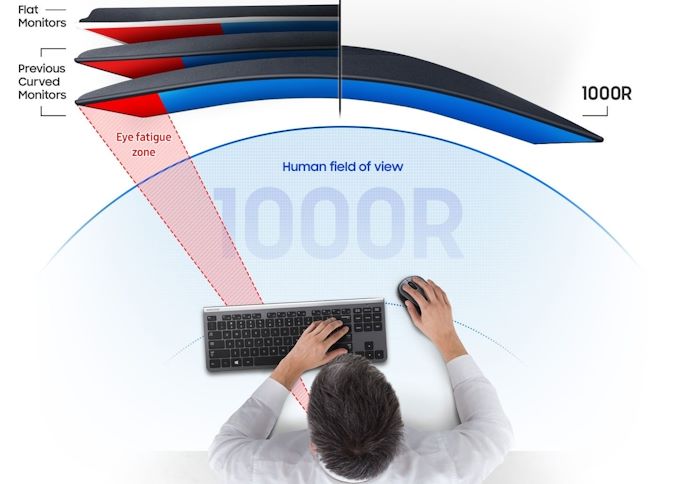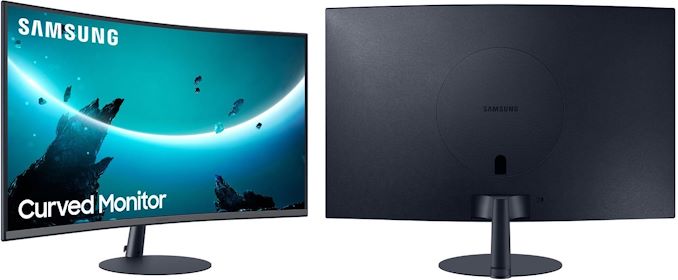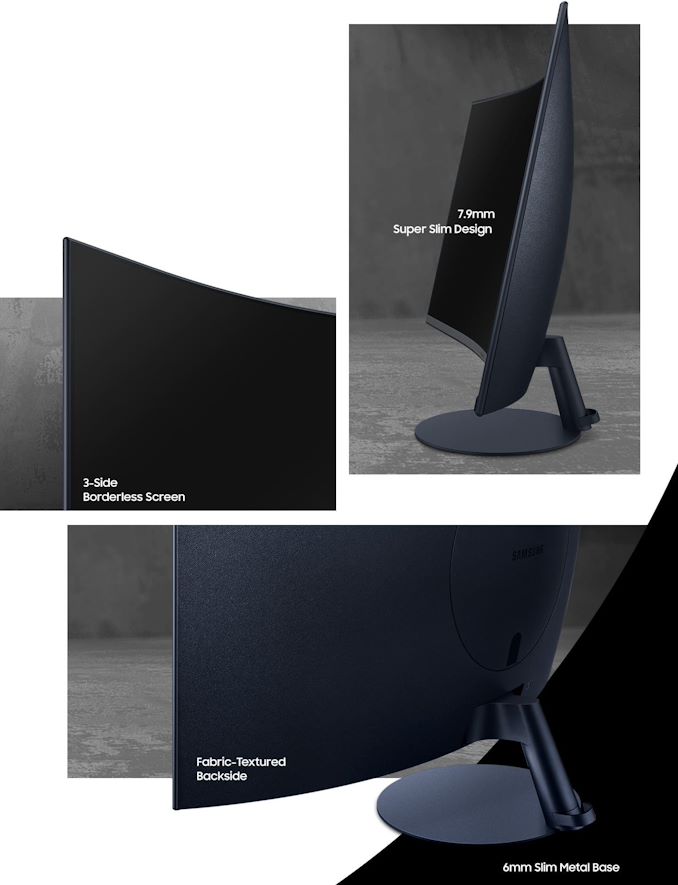Samsung Announces TD5 Monitors: Aggressive, 1000R Curved Office Displays
by Anton Shilov on March 3, 2020 10:00 AM EST- Posted in
- Monitors
- Displays
- Samsung
- FreeSync
- Curved Display
- Adaptive-Sync

As one of the major proponents of curved displays, Samsung has been applying curved panels to numerous monitors over the years. Many of these monitors have been aimed at gamers and prosumers, while for other market segments, such as SOHO, Samsung hasn't approached them with the same zeal for rounded displays. Last week, however, the company changed that, revealing its new T55 monitors that feature an aggressive 1000R curvature along with TÜV Rhineland’s Eye Comfort certification for certain models.
With the monitor market already beyond saturation with traditional displays, the key selling point for Samsung's TD5 displays is of course the 1000R curve. With most monitors on the market using 1500R or 1800R curves, the TD5s have a noticeably narrower curve than other monitors. Citing a a clinical study conducted by professor Seong-Joon Kim at Seoul National University Hospital, Samsung is promoting the new curved displays as provoking less eye strain than flat monitors, as they bring the whole picture closer to the human eye. Furthermore, Samsung says, because the 1000R curvature radius closely matches the human field of view, this is a more optimal curvature than less aggressive options. To that end, 1000R curvature is the core feature of the whole Samsung T55 lineup.
Overall, the T55 family consists of three models: the C24T55, C27T55 and C32T55, which offer 24-inch, 27-inch, and 32-inch diagonals respectively. All the LCDs use a 1920×1080 VA panel that offers a max brightness of 250 nits brightness, a 3000:1 contrast ratio, 4 ms response time, and a 75 Hz maximum refresh rate. The LCDs can display 16.7 million of colors and reproduce 119% of the sRGB, 88% of the Adobe RGB, and 88% of the DCI-P3 color spaces, which is quite good given their positioning (and the fact that their rivals usually support only the sRGB gamut).
The monitors feature a minimalist ‘3-side borderless’ design with a fabric-textured backside and use stands with a 6-mm slim metal base that can only adjust tilt. As for connectivity, the monitors have a DisplayPort input, a D-Sub input, and an HDMI port to ensure compatibility with both modern and legacy PCs.
Designed primarily for productivity/office workloads, the monitors are not exactly meant for entertainment uses, but Samsung nevertheless equipped them with a scaler that supports VESA’s Adaptive-Sync (and AMD FreeSync) variable refresh rate technology and added speakers to 27-inch and 32-inch models.
| General Specifications of Samsung's T55 Displays | |||
| C24T55 24-inch |
C27T55 27-inch |
C32T55 32-inch |
|
| Panel | 24" VA | 27" VA | 32" VA |
| Native Resolution | 1920 × 1080 | ||
| Maximum Refresh Rate | 75 Hz | ||
| Response Time | 4 ms | ||
| Brightness | 250 cd/m² | ||
| Contrast | 3000:1 | ||
| Backlighting | LED (?) | ||
| Viewing Angles | 178°/178° horizontal/vertical | ||
| Curvature | 1000R | ||
| Aspect Ratio | 16:9 | ||
| Color Gamut | sRGB: 119% AdobeRGB: 88% DCI-P3: 88% |
||
| Dynamic Refresh Rate Tech | VESA Adaptive-Sync (AMD FreeSync) |
||
| Pixel Pitch | 0.2767 mm² | 0.3113 mm² | 0.369 mm² |
| Pixel Density | 91.8 PPI | 81.6 PPI | 68.8 PPI |
| Inputs | DisplayPort D-Sub HDMI |
||
| Audio | audio in audio out |
audio in audio out 5W stereo speakers |
|
| USB Hub | - | - | - |
| MSRP | ? | ? | ? |
While Samsung lists all three T55 monitors on its website, the company yet has to reveal their exact launch dates or prices.
Related Reading:
- Samsung’s Odyssey Continues: Ultra-Curved QLED 49-Inch 240 Hz HDR1000 Monitor w/ Adaptive Sync
- Philips Reveals 346B1C 34-Inch 100 Hz Curved UltraWide Monitor with USB-C Docking
- HP’s E344c: A 34-Inch Curved Ultra-Wide Productivity Monitor
- Samsung Unveils CJ79 & CJ89 Curved LCDs: Quantum Dots, TB3 & USB-C
Source: Samsung DisplaySolutions (via Tom’s Hardware)













66 Comments
View All Comments
lilkwarrior - Tuesday, March 3, 2020 - link
That’s extremely narrow-minded with anecdotal fallacies why 120hz+ isn’t useful beyond gaming; most UX professionals, animators, & creative pros in general will strongly disagree with you.There’s a reason why the PA32UCG exists & so on. 4K@120hz+ is hard to quality control but strongly preferred by creative pros
p1esk - Tuesday, March 3, 2020 - link
He's trolling, ignore him.Beaver M. - Wednesday, March 4, 2020 - link
Yeah thats why even the best professional monitors rarely have more than 60 Hz, yet are still extremely expensive. That last one here on Andandtech even only has 10 ms reaction. For that even 60 Hz is too fast. 120 Hz would be completely useless. I think you dont know how refresh rate and panel reaction time are tied together. If one of both cant reach the others specs, then its as stupid as putting a Ferrari transmission into a 60 HP diesel car.jabber - Tuesday, March 3, 2020 - link
You have to remember most here have never had a 'proper job'. The mostly live in some IT fantasy land.surt - Tuesday, March 3, 2020 - link
Except for eye fatigue. But hey, it's your health if you don't want to care.Beaver M. - Wednesday, March 4, 2020 - link
Eye fatigue doesnt happen from scrolling while trying to read the scrolled stuff.It happens because of crappy lighting, or, on CRTs, because of low refresh rate. Refresh rate on CRTs and LCDs is not the same, though, unless youre using ULMB. And who uses that in an office?
p1esk - Wednesday, March 4, 2020 - link
It’s strange that you have the need to convince people that reading blurry text is ok. Why?drgigolo - Tuesday, March 3, 2020 - link
Been running a 4K monitor for years myself. 3 years this spring (with the launch of the 1080Ti). Besides, I doubt somebody who buys these does any kind of gaming?And, it is possible to use a computer for other things than gaming.
It is to me, a big mystery, why so many on the PC front don't do high res and most of all, high PPI. When you think about how high res mobiles have gotten. We now have 8K TV's. But desktops are stuck at 1080p and some 1440p. The PPI is horrible there.
It's been 8 years since Macs started coming with "Retina" displays. After about one new OS release, basically all Mac software supported these retina displays and the scaling is perfect.
Take a look at Windows, and that is hardly the case. Reading text on a sub-200 PPI display that is relatively close to your face is fugly.
boeush - Tuesday, March 3, 2020 - link
I agree... up to a point.Smartphone screens are typically held about 10 inches from the eyes, so high PPI is important there.
Desktop monitors, on the other hand, are supposed to be viewed at roughly arm's-length. If you are pressing your nose against your monitor, you're doing it wrong (and actively ruining your eyes). So, having smartphone-like pixel densities on computer screens is overkill, and is nothing but a giant waste of money, power, and performance - in other words, perfect marketing specs for the typical Apple user.
I think for desktop monitors a PPI in the range of 150-180 is about as much as one could realistically need, even with perfect 20/20 vision (as compared to 300+ PPI for "retina" displays.)
lilkwarrior - Tuesday, March 3, 2020 - link
Again, that’s extremely narrow minded. Heck a optometrist would disagree w/ you; a high PPI panel like the Pro Display XDR is invaluable for optimal eye health.It’s expensive but invaluable to creative pros and those who care about their health. Just like how a mechanical keyboard—like a $300+ Kenesis Advantage 2—is so worth it